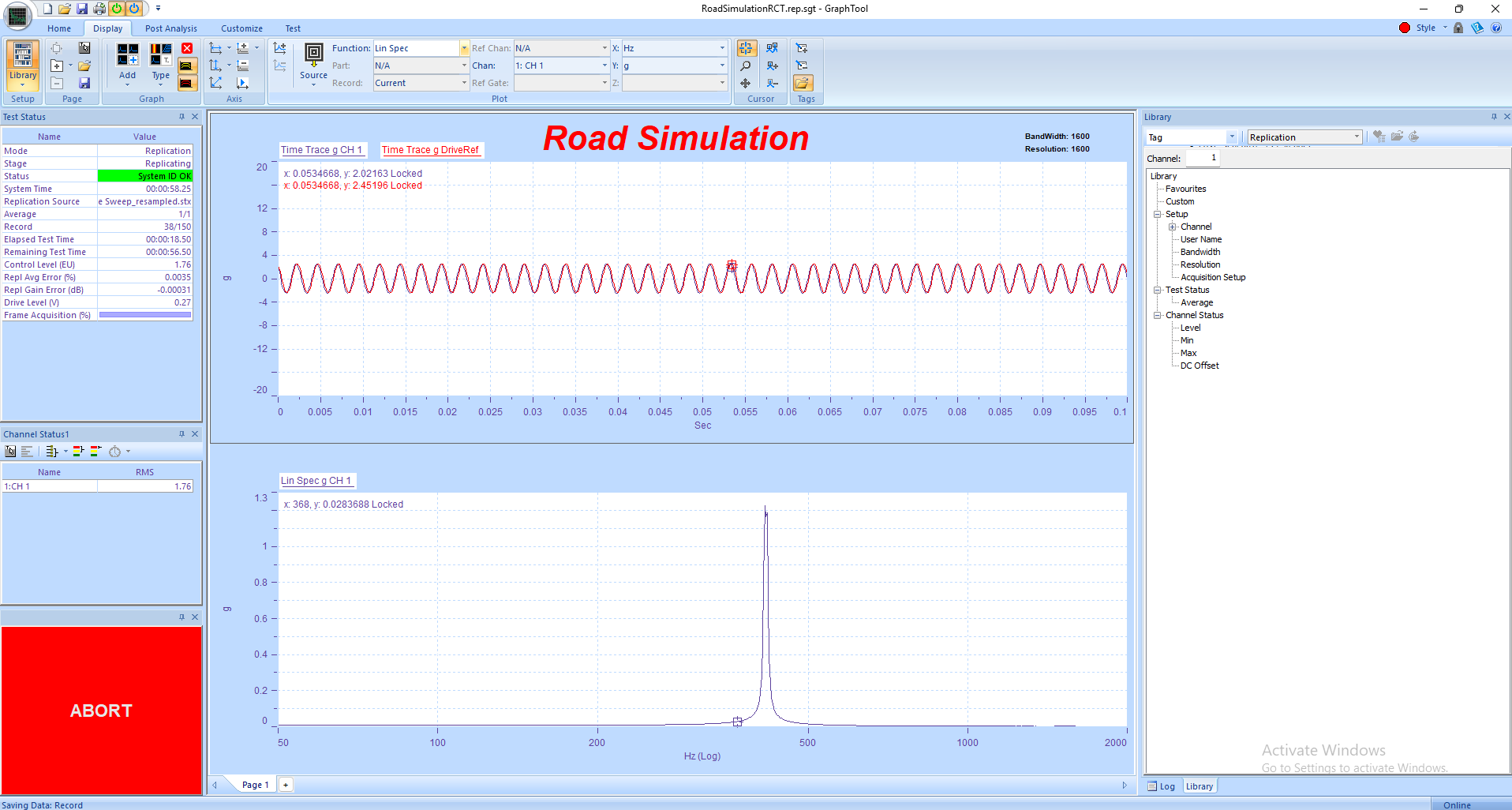Panther Field Data Replication Control delivers precision and performance in time-domain waveform reproduction. Built on Spectral Dynamics' heritage as the inventor of closed-loop digital vibration control, Panther combines advanced adaptive algorithms, comprehensive safety, and intuitive operation to provide trusted results, every time. Using advanced digital filtering, adaptive feedback, and the immense computational capability of the Panther platform, engineers can accurately duplicate complex field environments for verification, durability, and qualification testing. When quality of data is important, Panther sets the standard.

How Replication Works
Replication Control reproduces recorded time-domain waveforms captured during real-world events such as road profiles, aircraft takeoff, or launch vibrations. Using adaptive control and Spectral Dynamics' proprietary digital filtering, Panther ensures accurate reproduction of both amplitude and phase characteristics of the original waveform without requiring manual iteration. Real-time feedback from all input channels is analyzed continuously to maintain precise control, even under nonlinear or time-varying test conditions.
Gap-free streaming ensures that long-duration recordings can be replayed directly from disk in real time, with all data archived for post-test analysis. Panther's hardware-synchronized acquisition provides phase coherence better than one degree between all channels up to 100 kHz, guaranteeing time alignment and high-fidelity waveform reconstruction.
Ease of Use & Flexibility
Panther's Replication application simplifies even the most complex test setups. Through the Library feature, users can instantly access saved setups, data, and reports without navigating complex file paths. With an intuitive graphical interface and integrated Library access, users can configure, monitor, and replay data from previous tests quickly and confidently. The interface supports touch-screen operation and customizable layouts for both production and R&D environments. Easily and quickly compare data from different channels and different test runs. Panther's modern, touch-friendly interface makes operation fast and intuitive, for engineers at all experience levels.
Advanced Replication Control Technology
• Adaptive Time-Domain Control — Delivers faithful waveform reproduction without iterative tuning through proprietary adaptive feedback algorithms.
• Real-Time Gap-Free Streaming — Records and replays unlimited test durations directly to and from disk without data loss.
• Multiple Acquisition Streams — Supports independently selectable sample rates for optimized data handling across different signal types.
• Automatic NIST-Traceable Calibration — Ensures measurement accuracy for both input and output channels.
• Full Channel Synchronization — Maintains precise phase alignment across all channels (< 1 µs) for accurate multi-axis reproduction.
• Integrated Safety Monitoring — Performs over a dozen system and signal checks 25 times per second for operator and equipment protection.
• Powerful Library System — Provides fast access to setups and data with aliasing and favorites for instant recall.
• Live Data Analysis in GTX — Allows simultaneous visualization of response and control signals during streaming and control.
• Modern Touch-Friendly Interface — Designed for both novice and expert users on Windows PCs and touch-enabled devices.
• High-Resolution Acquisition — With simultaneous sampling across all channels at up to 262,144 samples per second and 24-bit ADC resolution, Panther accurately captures even the most demanding transient and high-frequency waveforms required for precise replication testing.
Safety and Reliability
Panther continuously monitors over a dozen critical parameters up to 25 times per second. Built-in watchdogs, automatic abort thresholds, and real-time feedback ensure operator and equipment safety. Safety isn't an afterthought — it's designed into the system.
Applications
Aerospace • Automotive • Defense • Electronics • Transportation • Energy
• Durability testing of automotive and aerospace components
• Road load and vibration environment reproduction
• Spacecraft launch profile replay
• Product verification using field-acquired vibration data
• Structural fatigue and reliability qualification
Technical Data Sheet
|
Input Subsystem |
Output Subsystem |
|
Input Channels: 8 channels (expandable up to 32) |
Dynamic Range: >110 dB |
|
Dynamic Range: >110 dB |
DAC: 20 Bit |
|
ADC: 24 Bit |
Max Output Amplitude: ±12 Volts Peak |
|
Voltage Ranges: ±12 V to ±0.5 V in 8 steps (Auto Ranging) |
Max Output Current: 16 mA |
|
Overload Detection: Full scale on all channels, analog and digital detection |
Amplitude Linearity: ±0.20% of value or ±0.03% of full scale |
|
Voltage Coupling: AC or DC or GND |
Max Output Rate: 262,144 samples per second |
|
IEPE Power: 4 mA (24 V max into open circuit) |
Image Attenuation: <96 dB |
|
Max Rated Input Signal: ±35 Volts Peak |
Frequency Accuracy: ±5 ppm |
|
Max Sampling Rate: 262,144 samples per second |
Reconstruction Filters: Analog (1 kHz, 10 kHz, 25 kHz or OFF, >96 dB attenuation, ±0.15 dB ripple) |
|
Sampling Interval: Simultaneous on all channels |
Output Offset Removal: Digitally Controlled, Accuracy Better than ±0.5% of Full Scale |
|
Frequency Accuracy: ±5 ppm |
Channel-Channel Match: ±0.25 dB amplitude, ±1° phase to 100 kHz |
|
Freq. Range Reduction: Digital decimation and filtering using on-board FPGA and DSP |
Channel Crosstalk: <-100 dB |
|
Anti-Aliasing Filters: Analog (524 kHz cutoff, >105 dB alias attenuation, ±0.10 dB ripple); Digital (variable, >96 dB @ Nyquist, ±0.15 dB ripple) |
Phase between Units: ±1° to 100 kHz |
|
Input Impedance: 1 MΩ |
Output Impedance: 60 Ω |
|
Connection Type: Pseudo-differential, 10 Ω to system ground, low side return |
Output Type: Pseudo-Differential, 10 Ω to System Ground Low Side Return |
|
Calibration: Automatic Internal Digital Calibration, NIST Referenced |
COLA Output Level: 1 Volt Peak (after analog smoothing filter) |
|
TEDS Compliant: Yes |
Output Cable: Designed to drive up to 50 ft of shielded 50 Ω coaxial cable |
|
|
Calibration: Internal Digital Calibration, NIST Referenced |
|
|
Host Communication: USB or Ethernet or Optional Wi-Fi |